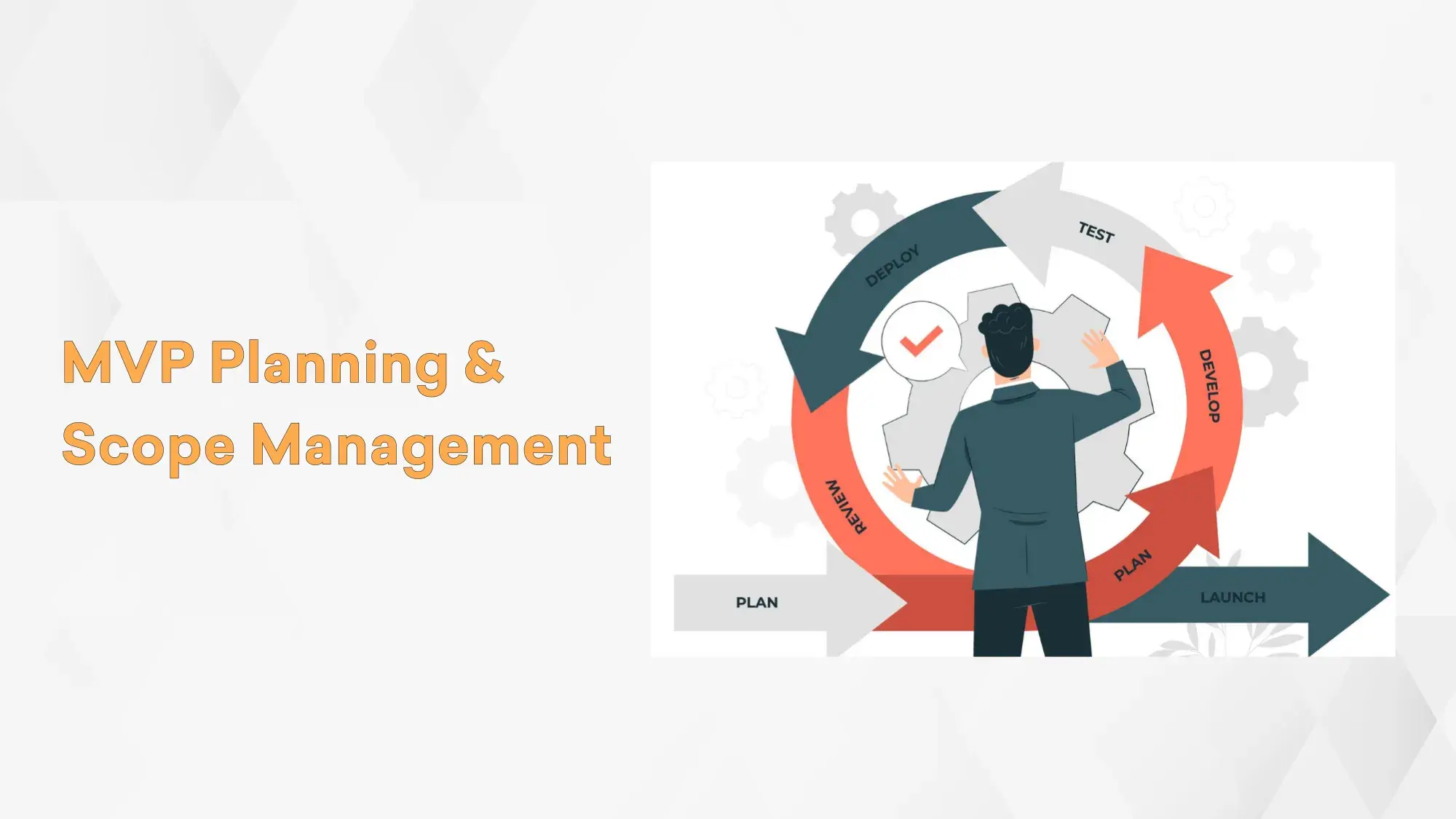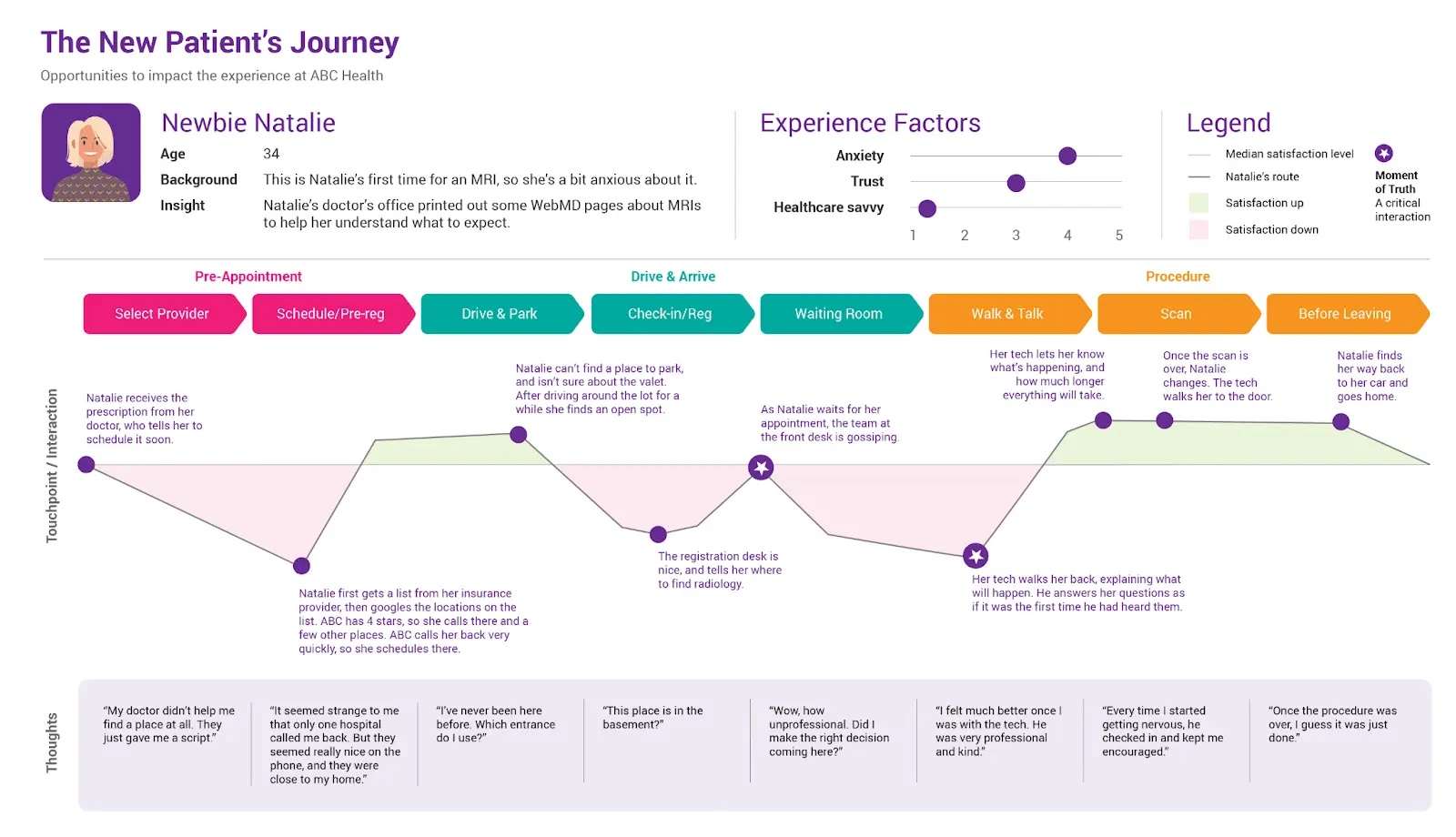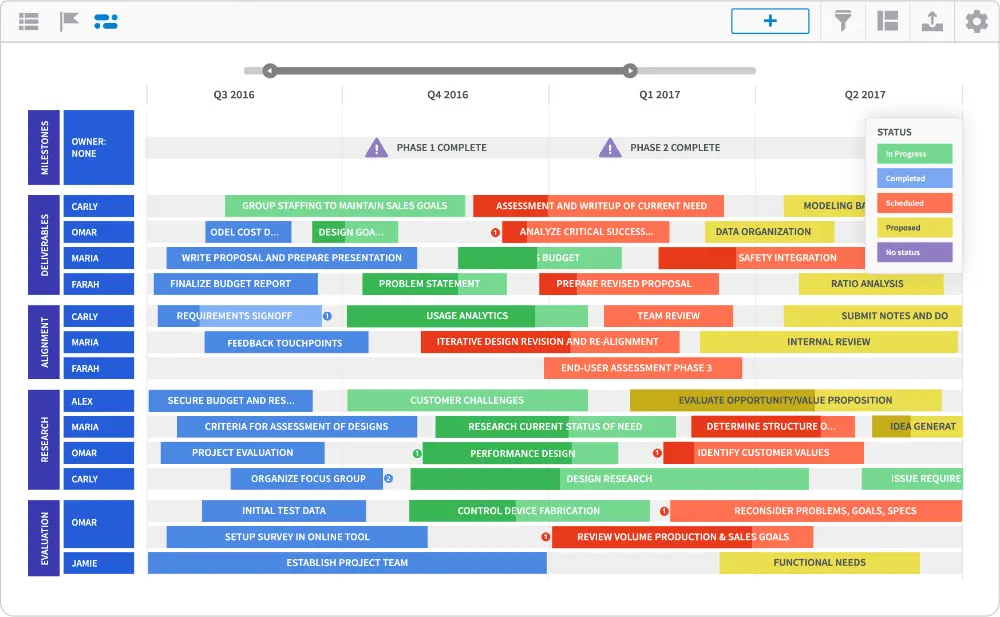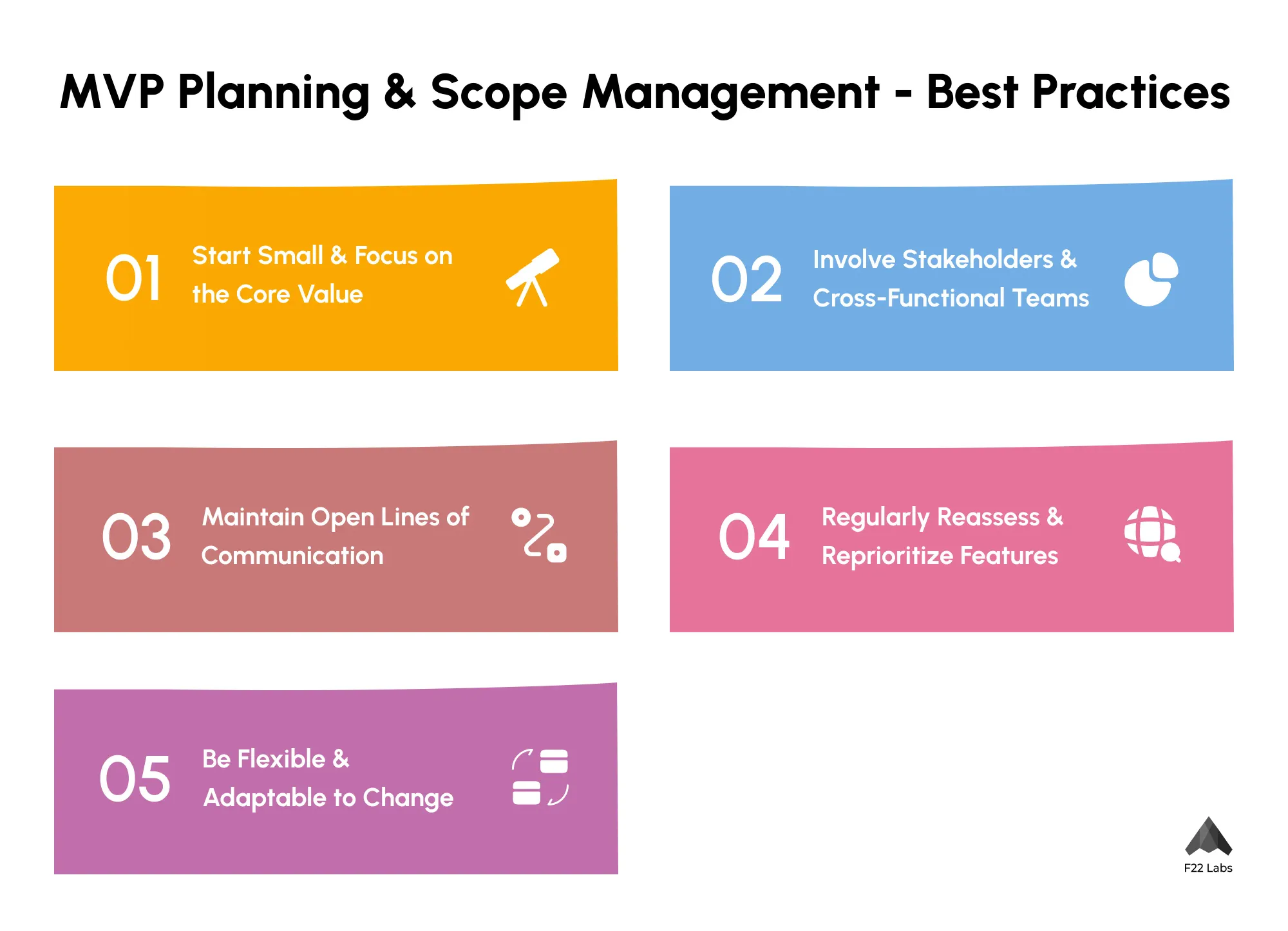MVP Planning & Scope Management

Have you ever tried to assemble a puzzle without knowing what the finished picture looks like? It can be an exciting yet tiring task, right? Now, imagine that puzzle as your project, and each piece represents a step in the process.
Suddenly, it's not just a game anymore; it's your vision, your hard work, and ultimately, your success at stake.
This is precisely what MVP planning feels like, especially when the scope management seems as elusive as the missing piece of your puzzle.
As the legendary American writer Mark Twain once said, "The secret of getting ahead is getting started."
The art of beginning, especially in the realm of MVP (Minimum Viable Product) planning, involves not just taking the first step but also understanding where each subsequent step should land. It's like finding your way through an intricate network of options. You know there's a goal – a product that spells success – but the path with its many twists and turns can make the journey challenging.
In today's fast-paced world, a significant 42% of startups fail due to a lack of market need for their products, as revealed by CB Insights. This fact highlights the need for adapting as the project progresses, a task made easier with scope management guiding the way.
When creating an MVP, planning and scope management are not mere extras, they're indispensable. As we explore further, let's see how these vital factors can serve as a guiding light, leading your MVP project to the success it deserves.
Importance of Planning & Scope Management
MVP planning and scope management are two halves of the same coin. One cannot truly succeed without the other. A well-planned MVP that considers the significance of scope management can prove to be a game-changer in your product development journey.
Importance of Planning in MVP Development
In a world driven by fast-paced technological advancements, speed is of the essence. But speed without direction is chaos. That's where the vital role of planning in MVP development comes into focus.
Planning is the compass that provides the necessary direction, guiding your project through the stormy seas of competition and market uncertainties.
An MVP, or Minimum Viable Product, is a product with just enough features to attract early adopters and validate a product idea early in the product development cycle.
The "minimum" aspect means focusing on core functionalities that address the problem it is intended to solve, while the "viable" aspect ensures that it provides enough value to customers to garner their interest.
So, what does MVP planning look like?
The MVP stages typically follow this sequence:
- Ideation
- Design
- Development
- Launch, and
- Learning.
These MVP steps are crucial in shaping the foundation of your product, providing you with insights into the market dynamics and customer preferences.
Scope Management
Scope management is like your project's guardian angel, silently working in the background to keep things on track.
In MVP planning, scope management plays an instrumental role. It helps in setting the MVP goals, ensuring the team is always on the same page about the project's vision and direction. The steps to build an MVP become a lot more manageable and streamlined when the scope is effectively controlled.
Scope management acts as a guide, ensuring your MVP roadmap stays clear of unnecessary complexities and deviations. It's an excellent tool in Agile MVP planning, as it helps teams stay focused on delivering incremental value while efficiently managing changes.
Moreover, effective scope management helps in mitigating risks associated with over or under-scoping. It ensures you don't bite off more than you can chew (over-scoping), or leave your MVP undernourished (under-scoping).
Steps for MVP Planning & Scope Management
The journey of MVP Planning involves a systematic progression of steps to shape your product from a conceptual stage to a tangible one that can be introduced to the market. According to entrepreneur.com, around 30% of tech startups fail, usually around 24 months after their first financing, mostly due to a lack of proper planning and execution.
This underlines the criticality of a solid MVP planning strategy. Let's walk through these MVP steps in more detail:
Define the Problem & Solution
A significant step in MVP planning revolves around defining the problem and the proposed solution. Here, you're identifying a pressing issue that your prospective users encounter and articulating how your product serves as a remedy.
Suppose your startup is developing a mobile app for a digital health company.
The problem could be: "Patients often find it hard to track their health metrics and consult with healthcare providers remotely."
The solution your MVP provides would then be: "Our app enables users to monitor their health metrics conveniently and facilitates virtual consultations with healthcare professionals."
Identify the Target Audience & Market
Understanding your target audience is a critical phase in the steps to build an MVP. It allows you to create a product that resonates with the needs and preferences of prospective users.
With the digital health app example, your target audience could include patients with chronic illnesses, fitness enthusiasts who want to track their health metrics, or even health professionals who need a platform to offer remote consultations.
Knowing your audience will help you identify the market needs and tailor your app's features accordingly.
Clear Objectives & Goals
Establishing clear objectives and mvp goals is like setting up a lighthouse that guides your product development journey. They ensure every feature you add brings you closer to your ultimate vision.
For the health app, a goal might be: "To simplify remote healthcare by providing a seamless platform for health monitoring and virtual consultations." Every step of your MVP planning, including design and development, would then align with achieving this goal.
Feature Slicing & Incremental Development
Feature slicing and incremental development is a modern approach that allows for faster delivery of functional products. It involves breaking down the product into manageable pieces or 'slices,' each adding a distinct value to the product.
For instance, in the development stages of your health app, you might prioritize creating basic features like health metric tracking and appointment scheduling first. Additional features, such as personalized health reports or integration with wearable devices, could be part of later stages.
User Story Map or Flowchart
Visualizing your MVP through a user story map or a flowchart is an essential step in the MVP planning process. This visual guide provides a clearer picture of your product's functionality and user flow.
When developing your health app, a user story map might begin with a user signing up and setting up their profile, then moving on to tracking their health metrics, scheduling an appointment with a healthcare provider, and so on.

This visualization helps identify any potential roadblocks in the user journey early in the development process.
Estimate Effort, Time & Resources
Estimating effort, time, and resources is a key stage in the steps to build an MVP. It involves evaluating the resources you have and the resources you'll need, quantifying the time commitment, and identifying the work that needs to be done.
For example, while building your digital health app, you'll need to consider the expertise required for design and development, the cost of cloud services, and the time required for testing, among others. Having a clear estimate prevents overruns and ensures that your MVP is developed efficiently and economically.
Project Timeline or Roadmap
Creating a project timeline or an MVP roadmap is like drawing the blueprint of a building before construction. It provides a visual representation of the project’s timeline, including key MVP milestones and deadlines, helping everyone involved stay aligned and on track.
When you're developing your digital health app, this roadmap might include when the user interface design should be completed, when the health tracking feature needs to be ready, when testing phases start, and more.

This timeline becomes your reference point throughout the project, keeping everyone focused on meeting the established milestones.
Scope Creep
Managing scope creep is an essential part of MVP planning. Scope creep refers to changes, additions, or expansions in the project's goals, objectives, or features that go beyond the originally agreed-upon scope.
While developing your health app, you might get tempted to add more features like integration with more wearable devices or adding a community forum. While these are great features, adding them prematurely could extend timelines, increase costs, and divert focus from your primary MVP goals.
Managing scope creep ensures that the project stays on track and your MVP remains true to its initial vision.
Agile Development
Embracing agile development is an integral part of modern MVP planning. The agile methodology involves iterative and incremental development, promoting adaptive planning and encouraging rapid and flexible responses to changes.
For your health app, agile development means your team would work on small, manageable parts of the project, get feedback, and make improvements before moving on to the next set of features. It helps in keeping the development process flexible, delivering value to users quickly, and adjusting to changes efficiently.
Project Management Tools
In the steps to build an MVP, project management tools can streamline the process, keeping track of tasks, progress, and collaboration. Tools like Asana, Jira, or Trello can help manage tasks, track progress, and facilitate communication, making the development process organized and efficient.
User Feedback & Iteration Cycles
Lastly, gathering user feedback and conducting iteration cycles are crucial MVP stages. Feedback is the compass that guides the iterative development process, allowing you to refine and enhance your MVP based on real user insights.
Once your health app MVP is in the hands of the users, their feedback could lead you to make changes, whether it's a tweak in the user interface or an upgrade in the existing features. Iterating based on user feedback ensures your MVP continually evolves to meet user needs effectively.
With all these steps in mind, product studios like F22 Labs can guide you through the process of MVP planning and development. Our experience in turning great ideas into successful digital products can ensure your MVP planning process is a guided, systematic, and successful endeavor.
Best Practices - MVP Planning & Scope Management
Navigating the nuanced path of MVP Planning is an art that requires strategic thinking, clear focus, and adaptability. With each project presenting unique challenges and opportunities, some established best practices can help streamline this process and ensure its success.
Start Small & Focus on the Core Value
When considering app development costs, remember that your MVP is just the beginning. While keeping initial expenses low is crucial, plan your budget with an eye on future growth. Balance investing in core features with maintaining flexibility for evolution. This foresight in financial planning can significantly impact your product's long-term success.
A fundamental principle of MVP planning is to start small, focusing on the core value proposition. It means zeroing in on the primary functionality that solves your user's problem and differentiates your product in the market.
Take the case of Spotify. Initially, it concentrated on its core value proposition: providing instant access to music. Instead of cluttering the platform with numerous features, Spotify began with a clear focus and gradually added more features, like personalized playlists and social sharing, as it gained more users and insights.
Involve Stakeholders & Cross-Functional Teams
Involving stakeholders and cross-functional teams in the planning process fosters diverse perspectives and comprehensive problem-solving. It encourages collaboration and ensures every aspect of the product gets due attention.
For instance, Slack, the renowned business communication platform, was initially designed by a small team who were themselves the first users of the product. They involved various stakeholders and teams in the MVP planning, which ensured a broad spectrum of user requirements was considered.
Maintain Open Lines of Communication
Effective communication is the glue that holds together any project. By maintaining open lines of communication, you ensure that everyone is aligned, reducing misunderstandings and facilitating efficient problem-solving.
The project management tool Trello was created by a team at Fog Creek Software to solve their own communication and collaboration issues. Their constant internal communication during MVP planning led to the creation of a tool that has revolutionized project collaboration for millions of users.

Regularly Reassess & Reprioritize Features
MVP planning is not a static process. Regularly reassessing and reprioritizing features based on user feedback and market conditions helps keep your product relevant and user-focused.
Twitter, for example, began as a simple platform for sharing status updates. As the market evolved and user feedback poured in, they reassessed their features and focused more on becoming a microblogging platform, thus resonating more effectively with their users.
Be Flexible & Adaptable to Change
Flexibility and adaptability are critical in any MVP planning process. While it's essential to manage and control project scope to avoid overruns and drifting goals, the ability to adapt to changes is equally important.
A great example is Netflix. It began as a DVD rental service but adapted its business model in response to evolving technology and user behavior. They maintained their project scope - providing entertainment content - while adapting to the massive shift toward digital streaming. Their agile MVP planning and adaptability have led them to become the giant they are today.
Remember, each product journey is unique, and MVP planning requires a mix of strategy, creativity, and adaptability. Drawing lessons from these examples and applying them to your context can greatly increase your odds of building a successful MVP.
The world of MVP planning can be complex and unpredictable, but with the right strategies, guidance, and partners, it is more than achievable. F22 Labs can help businesses traverse this journey, providing invaluable insights and strategies to navigate the mvp stages.
LinkedIn: A Case Study
LinkedIn, the world's premier professional networking site, stands as a testament to the power of meticulous MVP planning and robust scope management. This platform, conceived by co-founder Reid Hoffman and his team, was initially launched with a single, focused feature – enabling users to establish professional profiles and forge connections with others.
The brilliance of this strategy lay in its simplicity, demonstrating the essence of a Minimum Viable Product (MVP).
LinkedIn's journey is an ideal example of the MVP steps necessary for building a successful product. It highlights the mvp stages from concept development to scaling, offering a real-world mvp guide for other aspiring platforms.
Challenges Faced & Solutions Implemented
LinkedIn's journey wasn't devoid of hurdles. Below are the MVP challenges the company faced and how they tackled each one, painting a picture of their MVP planning and scope management.
| Challenge | Solution |
|---|---|
| User Acquisition | Initially, LinkedIn had difficulty attracting users. Many professionals were skeptical about the value of an online professional profile. LinkedIn tackled this by inviting prominent individuals to various professional networks, sparking growth. |
| User Engagement | Early on, LinkedIn experienced low user engagement. Users created profiles but didn't return frequently. In response, LinkedIn introduced the "People You May Know" and "Job Postings" features, promoting repeated visits and increased engagement. |
| Monetization | Finding ways to generate revenue without compromising the user experience was a challenge. LinkedIn introduced a freemium model, offering basic services for free and charging for premium features, thus ensuring a balance between revenue generation and user satisfaction. |
| User Retention | Keeping users engaged over the long term was a challenge. LinkedIn introduced regular content updates, industry news, and thought leadership articles to keep users coming back. |
| Privacy Concerns | As a platform dealing with professional data, privacy was a significant concern. LinkedIn invested in robust security measures and clear privacy policies to reassure users. |
| Competition | Standing out in the crowded social networking space was a challenge. LinkedIn focused on its unique value proposition as a professional networking site to distinguish itself from other social platforms. |
| User Interface | The need for a user-friendly interface was critical. LinkedIn continually improved its UI based on user feedback and industry trends. |
| Mobile Optimization | With the rise of mobile usage, ensuring a seamless mobile experience became crucial. LinkedIn developed a dedicated mobile app to cater to this need. |
| International Expansion | LinkedIn needed to adapt to different markets and cultures for global expansion. They implemented localizations and translations to cater to various regions. |
| Constant Innovation | To stay relevant, LinkedIn needed to constantly innovate. They launched features like LinkedIn Learning and LinkedIn Pulse to keep the platform fresh and engaging. |
Outcomes & Lessons Learned
The fruits of LinkedIn's labor in MVP planning and scope management are evident in its resounding success, with over 930 million users across 200 countries.
- Embrace the Power of Simplicity
LinkedIn started with a simple, focused feature: allowing users to create professional profiles and connect with others. It underscored the power of simplicity in the initial stages of an MVP.
- Prioritize User Engagement
To enhance user engagement, LinkedIn introduced features that encouraged repeat visits. It highlights the importance of evolving based on user needs and feedback.
- Ready to Adapt
The challenges LinkedIn faced required adaptability. They continuously reassessed their strategies and introduced new features to address arising needs and conditions, epitomizing agile MVP planning.
- Maintain a Unique Value Proposition
In a sea of competing social networking platforms, LinkedIn consistently underscored its unique value proposition as a professional networking site. This focus kept LinkedIn relevant and Be, no matter what new platforms emerged.
- Consistent Innovation is Key
In the face of changing market conditions and user demands, LinkedIn demonstrated the power of constant innovation. By introducing new features like LinkedIn Learning and LinkedIn Pulse, the platform managed to stay fresh, engaging, and most importantly, indispensable to its users.
LinkedIn's journey paints an informative mvp guide on how to navigate the often complex steps to build an mvp. Its path also shows the power of an effective MVP roadmap, as the company moved from strength to strength, overcoming hurdles, adapting to changes, and ultimately achieving its MVP goals.
Whether it's starting with a simple feature, ensuring user engagement, embracing adaptability, focusing on unique value, or constantly innovating, each lesson from LinkedIn’s journey can be instrumental for businesses embarking on their MVP planning journey.
The steps to build an MVP aren't linear or one-size-fits-all, but they do require a solid foundation in effective planning and a well-managed scope. And companies like LinkedIn showcase how to do it right.
Final Thoughts
MVP planning, when executed effectively, can transform a mere idea into a product that resonates with the market. The journey might seem daunting, with numerous MVP stages and intricate MVP steps to navigate, but the destination - a successful product that addresses a market need - makes it all worth it.
This journey is not just about launching a product, but it is about creating value. It is about setting clear MVP goals, following a detailed mvp guide, staying agile in your approach, and constantly evolving your product based on feedback and market dynamics. It's about adopting best practices and learning from companies that have done it right, such as LinkedIn.
And as the MVP roadmap unfolds, remember that you're not alone. F22 Labs is ready to walk this journey with you. With our expertise in MVP planning and scope management, we can help you navigate the labyrinth of building a successful MVP.
We offer a 1-hour free consultation with our MVP development service team to discuss your MVP vision and provide insights to kick-start your journey. Why not leverage their expertise and embark on the journey with a seasoned guide by your side?
Are you ready to put your idea into action and start your MVP journey?
Remember, every great product begins with an MVP, and every MVP begins with a plan.
